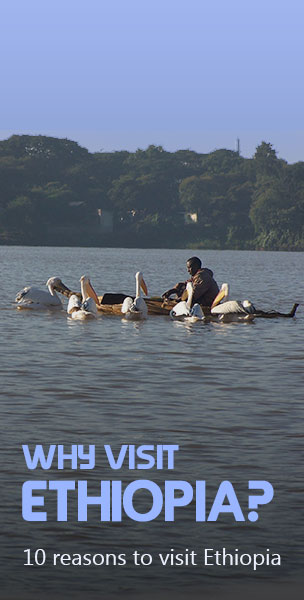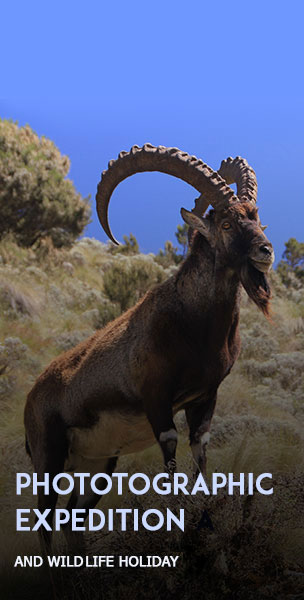Ethiopia is one of the world's great crossroads — where the peoples and cultures of Africa, the Middle East, and the Mediterranean have been interacting for thousands of years. The resulting ethnic and cultural diversity has given rise to many unique and dynamic visual traditions.
The strong religious setting, celebrations, and festivals play an important part in everyone's daily life. Church ceremonies are a major feature of Ethiopian life. The events are impressive and unique. The Ethiopian Orthodox Church has its own head, follows its own customs, and is extremely proud of its 4th-century origins.
Ethiopia's Islamic tradition is also strong and offers colorful contrast, particularly in the eastern and southeastern parts of the country. In fact, there were Ethiopian Muslims during the lifetime of Prophet Mohammed. This rich religious history is brought to life in the romantic walled city of Harar, considered by many Muslims to be the fourth "Holy City" following Mecca, Medina, and Jerusalem.
Truly a land of discovery, Ethiopia is mysterious, seductive, and extraordinary. Above all, it is a country of great antiquities, cultures, and traditions stretching back 3000 years. The country has thus been called a cultural mosaic, due to its 80 different languages and dialects and as many, if not more, cultural varieties.
Fascinating People
The Lower Omo is home to a remarkable mix of small, contrasting ethnic groups — not only the Bume and Konso, but also the Gelebe, the Bodi, the Mursi, the Surma, the Arbore, and the Hamer, to name but a few. Lifestyles are as varied as the tribes themselves. Lacking any material culture and artifacts common to other cultures, these tribes find unique ways in which to express their artistic impulses. Both the Surma and the Karo, for example, are experts at body painting, using clays and locally available vegetable pigments to trace fantastic patterns on each other's faces, chests, arms, and legs. These designs are created purely for fun and aesthetic effect, each artist vying to outdo the others.
The Afar
The Afar, most of whom occupy one of the most inhospitable desert or semi-desert areas in the world, have long been regarded as a fierce and warlike people. They are certainly proud and individualistic, and somehow manage to eke out a living from the challenging wilderness in which many of them live. The majority of the Afar are semi-nomadic pastoralists, but a minority have settled, notably those in the Aussa oasis. Almost all are Muslims and are organized into confederacies, tribes, and clans. The nomads live in small, isolated groups with the camel as their beast of burden and keep sheep, goats, and cattle.
The Anuak
The Anuak people are found in the Gambella region. The indigenous Anuak people are mainly fishermen in this region, and the crops they grow, for example sorghum, don't reach their full potential because of the extremely basic methods employed. There are few large villages, as people prefer instead to group together around a mango grove in the extended family compound of no more than five or six huts.
Amhara
The Amhara women wear dresses with a tight bodice and full skirt. The dresses are bright white with colored embroidery and woven borders. The men are resplendent in white jodhpurs and tunics. Although originally most of the border designs were based on the varied designs of the Ethiopian cross, today you sometimes see more modern motifs — flowers, birds, and even airplanes.
Harari
The Muslims of Harar wear colorful dress. The men often dress in red, purple, or black. The women of Harar part their hair in the middle and make large buns behind their ears. Harari women have been known for their basketwork for centuries and still weave intricate creations from coloured fibers and grasses. Harar is also famous for the work of its silversmiths, who craft beautiful anklets, necklaces, arm bands, silver chains, bangles, and earrings out of the precious metal. Although these items can be purchased at the market, some of the best selections can be found in the homes of the craftsmen and women.
The Oromo
The Oromo people offer their products for sale in open markets. They produce the more familiar grains and vegetables of established agriculture. Coffee, one of the world's favorite beverages, is believed to have been 'born' in this region.
The Somali
The lowland Somali wear long, often brightly coloured cotton wraps, while some of the cattle-herders in the lake district have clothing made of skins.
The Tigray
The women of Tigray wear dozens of plaits (shuruba) tightly braided to the head and fuzzing out at the shoulders. Young children often have their heads shaved, except for a tuft or a small tail of plaits, which are left so that if God calls them 'He will have a handle by which to lift them up to Heaven'.
The South People
The Southern region comprises hundreds of ethnic groups. The region of the south of Konso and Yabello is inhabited by the Konso people. Except for trading with the neighboring Borena for salt or cowrie shells, outside influence had, until recently, virtually passed by the Konso. The cornerstone of Konso culture, however, is a highly specialized and successful agricultural economy that, through terracing buttressed with stone, enables them to extract a productive living from the none-too-fertile hills and valleys that surround them.
Join us on a a unique journey to some of the most remote tribes of Ethiopia. Our tribal tours and cultural tours are well designed by our experts and led by our passionate, expert cultural tour guides. Contact us for a custom-made unique cultural holiday in Ethiopia.




